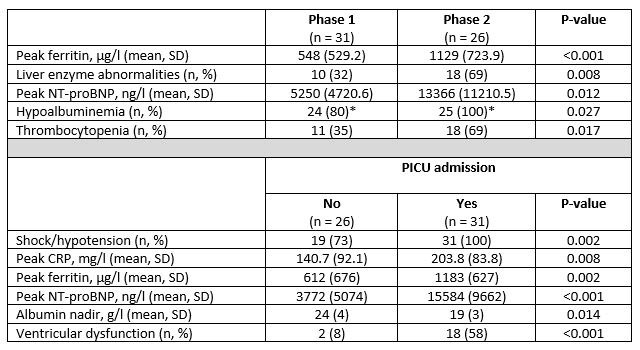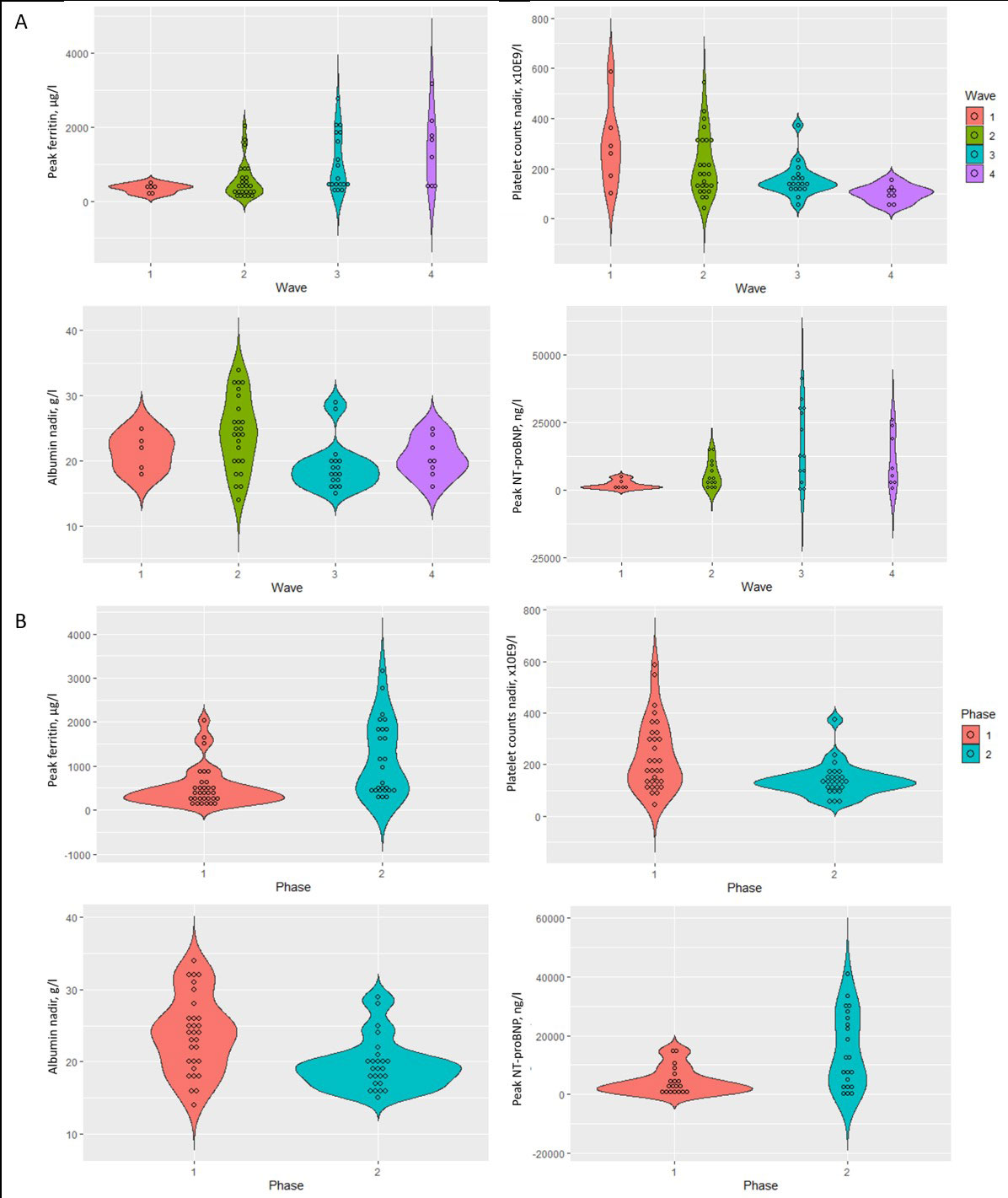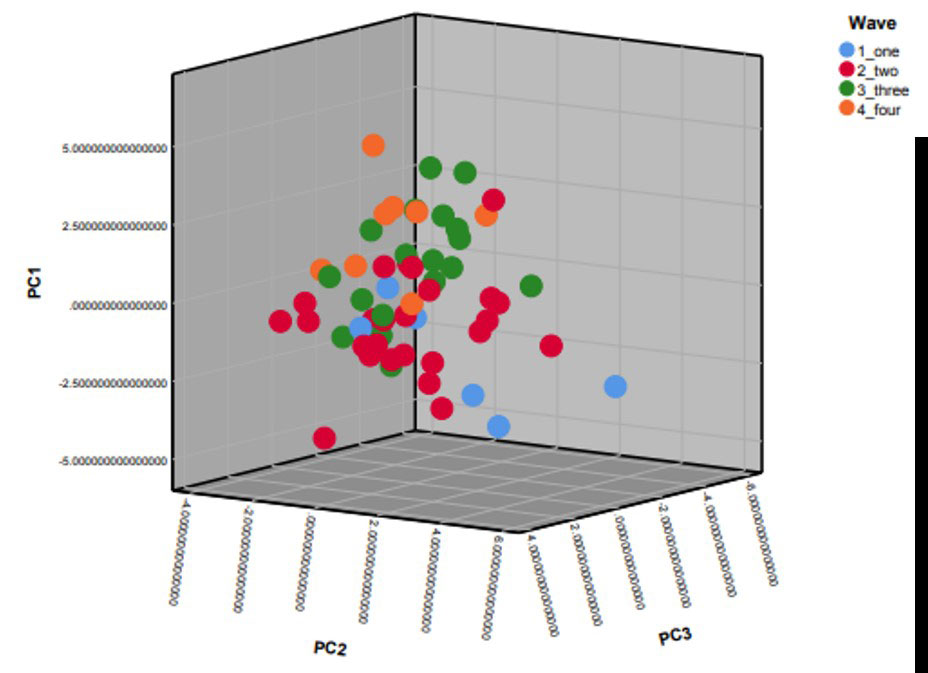Session Information
Session Type: Poster Session D
Session Time: 1:00PM-3:00PM
Background/Purpose: The COVID-19-associated multisystem inflammatory syndrome in children (MIS-C) is characterized by Kawasaki disease (KD)-like mucocutaneous features. The clinical course is often unpredictable. The goals of the current study were (a) to compare MIS-C phenotypes across the different waves of the COVID-19 pandemic, and (b) to identify variables associated with pediatric intensive care unit (PICU) admission.
Methods: Youth aged 0-18 years, fulfilling the World Health Organization MIS-C case definition, and admitted to the Alberta Children’s Hospital during the first four waves of the COVID-19 pandemic (May ’20-December ’21) were included in this observational cohort study. Captured data included KD-like manifestations, clinical signs of shock/hypotension, peak C-reactive protein (CRP) and ferritin, platelet count nadir, peak NT-proBNP and troponin, liver enzyme abnormalities, sodium and albumin nadir, echocardiogram findings, PICU admission, and use of biologic agents. MIS-C features were compared across the different waves. Variables associated with PICU admission were established using univariate analyses and multivariate logistics regression models.
Results: Fifty-seven MIS-C patients (median age 6 years; 72% males) were included. Fifty-four per cent required PICU admission. All received immunoglobulins, 77% received corticosteroids, and 14% were treated with biologic agents. Patients presenting during the third (April-July ’21; Alpha variant) or fourth wave (August-December ’21; Delta variant) presented with higher peak ferritin (p< 0.001) and NT-proBNP (p=0.012) levels, and a higher prevalence of liver enzyme abnormalities (p=0.008), hypoalbuminemia (p=0.027), and thrombocytopenia (p=0.017). An unsupervised clustering model correctly classified 49.1% of the patients in the correct wave without having access to this information. In univariate analyses, PICU admission was associated with the presence of shock/hypotension (p=0.002), higher CRP (p=0.008), ferritin (p=0.002), and NT-proBNP levels (p< 0.001), lower albumin levels (p=0.014), and ventricular dysfunction on echocardiogram (p< 0.001). A multivariate logistic regression model combining peak NT-proBNP, troponin, and ferritin levels as covariates explained 70% (Nagelkerke R2) of the variance in PICU admission and correctly classified 91% of the cases. NT-proBNP was the sole significant contributor in this model (p=0.017).
Conclusion: MIS-C patients presenting in a later stage of the pandemic displayed a different phenotype including a predominance of features associated with macrophage activation syndrome, such as higher ferritin levels, liver enzyme abnormalities, and thrombocytopenia. This may reflect the impact of distinct SARS-CoV-2 variants. NT-proBNP emerged as the most crucial MIS-C feature associated with PICU admission, underscoring the value of monitoring.
To cite this abstract in AMA style:
Renson T, Forkert N, Amador K, Miettunen P, Parsons S, Dhalla M, Johnson N, Luca N, Schmeling H, Stevenson R, Twilt M, Hamiwka L, Benseler S. Reading the Waves: Identifying Distinct Phenotypes of Multisystem Inflammatory Syndrome in Children During the 2020-2021 COVID-19 Pandemic [abstract]. Arthritis Rheumatol. 2022; 74 (suppl 9). https://acrabstracts.org/abstract/reading-the-waves-identifying-distinct-phenotypes-of-multisystem-inflammatory-syndrome-in-children-during-the-2020-2021-covid-19-pandemic/. Accessed .« Back to ACR Convergence 2022
ACR Meeting Abstracts - https://acrabstracts.org/abstract/reading-the-waves-identifying-distinct-phenotypes-of-multisystem-inflammatory-syndrome-in-children-during-the-2020-2021-covid-19-pandemic/



